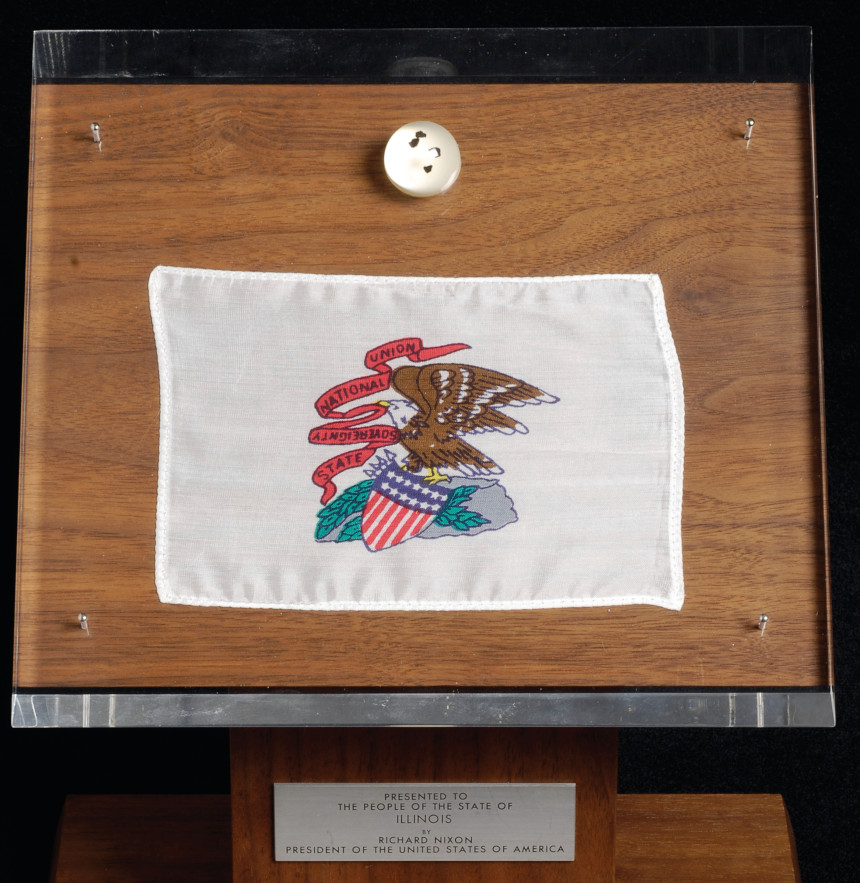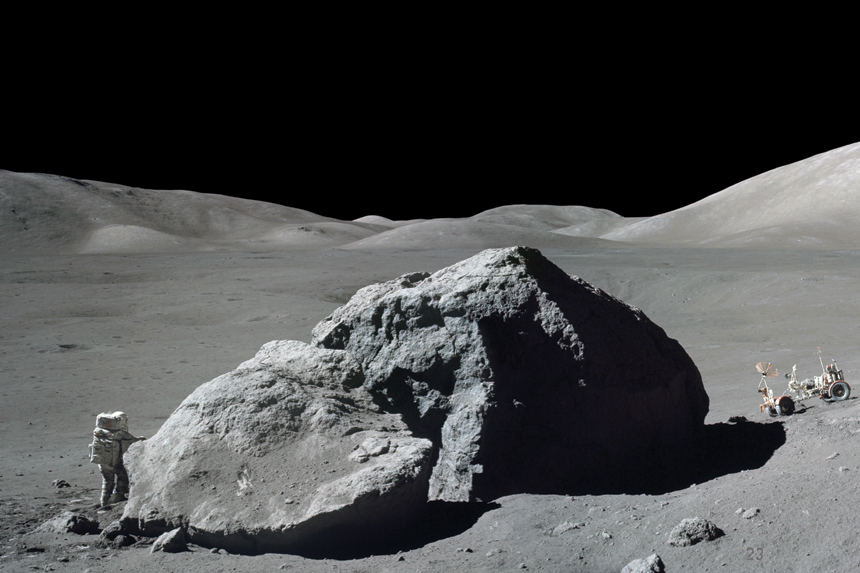If you happen to be in possession of a stolen piece of the moon, look over your shoulder.
Joe Gutheinz is after you.
Not that the moon misses those rocks — there’s plenty more where that came from — but Americans paid upwards of $25 billion to bring back just 842 pounds of soil and stones during six Apollo missions from 1969 through 1972, and it doesn’t look like we’ll be scooping up more any time soon.
Combine the exotic appeal of moon rocks with the limited supply of them, and you’ve got a commodity that’s a prime target for people looking to make a buck. “One guy was asking for $5 million for a few grams of moon rock,” says Gutheinz. “Five million! I wasn’t sure even a moon rock was worth that much money, so I checked around on the black market.
“Turns out, $5 million is just about right.”
They’re the ultimate hot rocks.
Following Apollo 11, America’s first lunar mission, the U.S. presented a few tiny moon rocks, embedded in Lucite balls, to every U.S. state and territory — and 135 more to every nation of the world. Each was mounted on a plaque bearing the name and flag of the state or country to which it was presented. You’d think all the lucky recipients would have taken good care of those infinitely rare specimens. And you’d be wrong.
For more than 20 years, Gutheinz has been known as the Moon Rock Hunter. He started out tracking down crooks selling fake lunar samples, but very soon found himself hot on the trail of actual stolen moon rocks and the shady characters who peddled them. Through hushed phone calls, clandestine meetings in distant cities, and expeditions to the darker corners of the internet, Gutheinz always got his man — and his moon rock.
One look at Gutheinz, with his square jaw and determined stare, and it’s clear he’s not a guy you want to mess with. For years, he was a top agent in NASA’s Office of Inspector General, tracking down and prosecuting contractors who bilked the agency. Whether it was a simple matter of overcharging NASA for services or a complex scheme where a guy rented warehouses from himself and then double-charged the agency, Gutheinz was legendary for following each receipt and canceled check to the last ill-gotten penny.
“That was fun,” Gutheinz says — but what he really liked was tracking down crooks who said they had moon rocks for sale.
You may be surprised to learn that people have been selling fake moon rocks almost from the moment Neil Armstrong, Buzz Aldrin, and Mike Collins returned from the first lunar mission in 1969.
“It was actually a pretty big thing,” says Gutheinz. “It really began in 1969, when a door-to-door salesman in Miami was selling bogus moon rocks that he claimed came from the Apollo 11 mission.”
Hard as it is to believe that even the most gullible mark would fall for a line like that, you need only look back through history to realize those poor saps in Miami were following a long, time-honored tradition: For centuries, con men have peddled bogus bits of history, ranging from splinters of the True Cross to strands from George Washington’s wig. In all likelihood, some Neanderthal guy went cave-to-cave selling fake mastodon teeth.
Luckily for Gutheinz, many of the would-be moon rock sellers were even dumber than their victims.
“Here’s an example,” says Gutheinz, and from the excitement in his voice you can instantly tell moon rock stories are his favorite kind. “In the 1990s, a guy named Ronald Trochelmann and his brother were trying to sell a moon rock at auction.
“Let’s just get the moon rocks back… so people can appreciate the fact that humans went to space and walked on another world.”
“The FBI got a tip-off on that one, because they were saying John Glenn gave it to their father after he returned from the moon.
“Of course, they didn’t study their history close enough and didn’t realize John Glenn never got to the moon!”
What makes a good fake moon rock? It’s not rocket science: “Mostly they’re rocks you pick up in your backyard,” Gutheinz says. “Then you jack it up with some sort of fake NASA letterhead indicating that Neil Armstrong gave it to you.
“The thing is, it’s a perfect scam. You tell your mark, ‘Look, I’ve got this moon rock from Neil Armstrong, and I’ll sell it to you for a measly 18 grand. But you can never tell anybody you’ve got a moon rock, because NASA says it’s a national treasure, and if you tell anybody about it, agents will kick down your door and grab it!’
“So nobody talked about having a moon rock, or they waited years to talk about it. And we were there waiting around to hear from victims who had good reason not to fess up.
“Finally, one day I said, ‘Gee, we’re doing this backwards. We need a sting operation.’”
In 1998, Gutheinz and his NASA team, along with the U.S. Postal Service and U.S. Customs, launched Operation Lunar Eclipse, a nationwide sting operation aimed at shutting down the fake moon rock trade. The quarter-page ad in the September 18, 1998, issue of USA Today was remarkably frank: A company called John’s Estate Sales was interested in buying moon rocks. If you have a moon rock you want to sell, call this number.
The home office of John’s Estate Sales was, in fact, a small room at the NASA Inspector General’s Houston office. In that room was a small desk, a tape recorder, and a telephone. Nothing else.
“It’s called a hello line,” says Gutheinz. “And there’s only one reason to answer it: Someone is calling to sell a moon rock.
“My undercover name was Tony Coriasso. If the phone rang, I’d walk across the office, pick up the phone, and say, ‘John’s Estate Sales, Tony Coriasso speaking,’ and we’d go from there.”
“From there” often entailed a delicate game of cat and mouse as Gutheinz played the skeptical dealer and the person on the other end of the line tried to figure out if this was some kind of trap. Of course, it wasn’t a fair fight: The sellers were amateurs and Gutheinz was a pro.
Operation Lunar Eclipse was a stellar success. One by one, furtive “moon rock” owners came forward only to face the double humiliation of being caught — and learning their treasured moon rock probably came from a backyard in North Jersey.
Business was good in the fake moon rock racket. But then one day, Gutheinz recalls, he got a call unlike any of the others. “This guy says, ‘Hi Tony, I saw your ad in USA Today. I wanna tell you something: All those people calling you? They’re calling you with bogus moon rocks.’”
Gutheinz nodded to himself. Yeah, he thought, tell me something I don’t know.
And then the guy did just that: “I’ve got the real thing.”
Of course, all the callers insisted they had “the real thing.” But there was something about this guy that sent a tingle up Gutheinz’s spine.
“Here’s the deal,” said the voice. “I’ve got a real moon rock, and if you go to this web page you’ll see it.”
Gutheinz wrote down the web address, pulled up the page — and couldn’t believe his eyes. There was a photo of a 10-by-14-inch plaque. Mounted on it was a Lucite ball — and embedded in the ball Gutheinz could clearly see a tiny pebble. On the face of the plaque was a plate depicting some national flag, but a piece of black tape obscured most of it, shielding the country’s identity.
“It’s an Apollo 17 moon rock,” the seller said — and at that moment Gutheinz realized the guy was probably telling the truth. Apollo 11’s moon rock plaques had a scattering of lunar pebbles embedded in their Lucite balls. After America’s final lunar mission, Apollo 17, more plaques were distributed, only this time each Lucite ball contained just a single small rock, like the one Gutheinz was looking at on his computer screen.
Posing as Tony, Gutheinz told the guy he was interested and set up a meeting in Miami. Gutheinz met the seller, a Miami businessman named Alan Rosen, in a restaurant. To Gutheinz’s dismay, Rosen didn’t bring the rock. He did, however, come with the story of how he got it. “He told me it was brought into the U.S. but not disclosed to Customs, which you’re supposed to do,” says Gutheinz.
“Meanwhile, I was working with the lunar curators at NASA, and I found out we did not keep any kind of records of where the recipient states, territories, and countries kept their moon rocks.”
From the mostly obscured national flag on the plaque, Gutheinz knew the rock was from one of six Central American countries.
“I checked with each of them, and it turned out not one of those countries knew where their moon rocks were. Not one! What’s more, Nicaragua allegedly had a moon rock that was sold in the Middle East for between 5 and 10 million dollars.”
Based on that market price, Gutheinz made Rosen a low-ball offer: $5 million. Rosen agreed, but before he turned over the rock, he wanted to see the money.
That was a problem. NASA doesn’t keep that kind of cash lying around, especially for the purpose of flashing it before the eyes of a smuggler. On the other hand, Gutheinz was in Texas, where more than a few super-rich patriotic Americans might be willing to help preserve a piece of U.S. history. For Gutheinz, the first such billionaire to try was obvious: He placed a call to the office of H. Ross Perot. And of course, the flamboyant billionaire and two-time U.S. presidential candidate jumped at the chance to be part of an out-of-this-world sting operation. “Perot was great,” says Gutheinz. “He put up the $5 million.” Perot designated the cash to an account at the Miami bank where Rosen said he had the rock stashed and instructed the bank’s vice president to produce a letter stating that the $5 million was to be used for the purchase of a moon rock. According to the elaborate plan, “Tony” got to select the bank officer who would take a picture of the rock at the Miami bank and send it electronically to him in Houston so he could confirm the rock was the real deal.
Still, Rosen was suspicious. On the day he was to reveal the rock in the Miami bank, he insisted that Gutheinz call him from Houston, to prove he wasn’t a federal agent waiting in the next room to spring a trap. When Rosen’s cellphone showed Gutheinz’s call coming from Houston, he was satisfied. “But he didn’t know how cellphones work,” says Gutheinz. “His phone showed I was calling from a Houston area code — but it didn’t show where I was actually at!”
He was, as Rosen had feared, right there at the Florida bank. And the “bank officer” was an undercover U.S. Customs agent. The moment Rosen produced the telltale Lucite ball, the agent confiscated it — and Gutheinz swooped in to make the arrest. “We looked in the trunk of his car, and there was the 10-by-14-inch plaque, without its Lucite ball. It had been given to Honduras.”

Besides tracking down moon rocks and nabbing crooked contractors, Gutheinz also headed up investigations into the dangers present in the Russian MIR spacecraft. He unmasked an astronaut impostor named Jerry Allen Whittredge who actually bluffed his way into Mission Control and walked off with schematic drawings for the space shuttle. But after his experience with Rosen, he began losing interest in hustlers selling fake moon rocks and found himself thinking more and more about how many of the real ones were missing — and was frustrated that NASA didn’t have the resources to launch a full-scale search. So when he retired from NASA in 2000 and began teaching classes at the University of Phoenix, he decided to give his criminal justice graduate students some unusual field experience: Tracking down those missing rocks.
“Over a 10-year period, our Moon Rock Project used about 1,000 students to find moon rocks,” he says. “They loved it. Besides the Honduran moon rock, with my students we found 78 more.”
There’s no telling how much skullduggery goes into the black market of moon rocks that were given to other countries, but within the U.S., it appears most of the missing rocks were simply carried out the door by state officials who thought they were entitled to them.
“Colorado Governor John Vanderhoof was a war hero, but he apparently didn’t understand that the moon rock was given to the state, not to him,” Gutheinz says. “So when he left office in 1975, he just grabbed the Apollo 17 plaque and took it home. It hung there for 25 years, until 2010.
“Then you have Arch Moore Jr., the governor of West Virginia. When he left office under a cloud, he took the state’s moon rock. He gave it to his law partner, and it ended up hanging in that guy’s garage.
“When Missouri Governor Kit Bond became a senator, he took the state’s moon rock with him to D.C.
“So there you have three governors who each walked out the door with a $5 million moon rock!”
Coleman Anderson was one of the original Alaskan boat captains in the cable series Deadliest Catch — but his most valuable catch was arguably Alaska’s Apollo 11 moon rocks. Anderson got the rocks from his foster father, who was curator of the state transportation museum in Juneau at the time the place burned down in 1973. The rocks were assumed lost in the fire, but that wasn’t the case.
“He found the plaque after the fire, saw it was in pretty good shape, and took it,” says Gutheinz.
In 2011, after word leaked out that he had the rocks, Anderson sued the state seeking permanent ownership, claiming they had been abandoned.
“Or else,” says Gutheinz, “he offered to return the rocks if the state paid him a monthly maintenance fee for all the years he had it.
“He lost that case. It wasn’t his rock.”
There’s no question that anyone who has an Apollo moon rock is probably in possession of stolen property, but Gutheinz isn’t interested in punishing the people caught with secret stashes. “We never accuse anyone of wrongdoing, of stealing the moon rocks,” he says. “Let’s just get the moon rocks back, put them in museums and planetariums and universities so people can appreciate the fact that humans went into space and walked on another world.”
These days, Gutheinz’s bread-and-butter business is his Friendswood, Texas, law firm, which specializes in criminal defense and family law. Two of his sons, fellow U.S. Army veterans, are partners. But he’s still hot on the trail of missing moon rocks as well as other lost pieces of America’s space program legacy.
“Right now I’m tracking down a Gemini space capsule,” he says. “Actually, it was probably a training capsule, but it would still be worth finding.
“A guy’s father had it, and he gave it to a city. Then the city lost control of it, and they have no idea where it is. Finding a capsule is a little different from finding a moon rock. It’s harder to hide. If I had to guess, it’s probably in plain sight, in some school playground.”
Meanwhile, Gutheinz is still hopeful he can make a dent in the list of still-missing U.S. state and territory moon rocks from Apollo 11 (Delaware, New York, U.S. Virgin Islands) and Apollo 17 (Louisiana, Michigan, New Jersey, Ohio, South Carolina, Puerto Rico). He’s less interested in tracking down the nearly 200 other moon rocks that are still at large around the globe. “When you give two moon rocks to the government of Moammar al-Gadhafi,” he says, “Don’t be surprised when they’re not there anymore.”
“Colorado Governor John Vanderhoof was a war hero, but apparently didn’t understand that the moon rock was given to the state, not to him.”
Other than the thrill of the chase, just what is it about finding moon rocks that is so compelling to Gutheinz? The answer might lie in a chat he had one day with a NASA astronaut.
“I asked him, ‘Are these things really worth $5 million?’
“He said, ‘Joe, I don’t have a clue what they’re worth. But let me tell you what they’re worth to me. When I was a kid, I always wanted to be a pilot. Then I went to a museum. I was walking in there, and there was this moon display — and this rock. As I got closer, it changed me. I’d always wanted to be a pilot — now I wanted to be an astronaut.’
“That really hit me. These dictators and kings who keep their country’s moon rocks for themselves, they’ve got the wrong idea. Moon rocks aren’t for the very wealthy. They’re for the very poor, to see a moon rock in a museum, and to have that kind of experience. It’s cool to think I can get just one moon rock back, and then some kid who can’t even afford to buy good shoes walks into a museum and sees that moon rock and says, ‘You know what? Do a little math, a little science, and who knows? Maybe I could go into space.’
“That I can understand. It’s a worthy goal.”
This article appears in our May/June 2019 issue. Subscribe to the magazine for more art, inspiring stories, fiction, humor, and features from our archives.
Featured image: NASA/Eugene Cernan
Become a Saturday Evening Post member and enjoy unlimited access. Subscribe now




Comments
We have not yet posted the complete version of this article online for our general readers. However, if you’re a subscriber/member, you can read the entire issue online (including this article), by going to https://www.saturdayeveningpost.com/flipbooks/issues/20190501/. Make sure to login first. Enjoy!
Why can’t I read the full articles on my iPhone when I’m logged in?